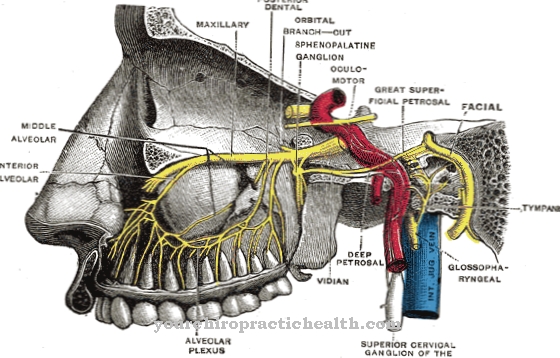Of the Ball of the big toe is a functionally important area on the sole of the foot. It plays an important role in the statics of the foot.
What is the ball of the big toe?
The ball of the big toe is an enlarged, downwardly curved region on the inside of the sole of the foot in the area of the metatarsophalangeal joint of the big toe. It belongs to the ball of the toe as a whole, which impresses as a transverse bulge of the sole of the foot in the area of the forefoot and represents the largest single region in this system.
It is made up of 3 layers, which are formed by different tissue structures. The solid framework in the depths is formed by the bones that belong to the 1st metatarsal bone and the metatarsal phalanx. The middle layer consists of muscles and the outer layer is made up of the skin and the subcutaneous fat pad with parts of the plantar fascia. This creates a cushion structure that is both soft and firm, which can absorb and distribute forces very well.
The ball of the big toe represents a strategic key point for the arch of the foot. The longitudinal arch stretches on the inside of the sole of the foot as an arch from the heel to the ball of the big toe, just as the transverse arch from the ball of the little toe ends there.
Anatomy & structure
The metatarsophalangeal joint of the big toe is formed by the head of the first metatarsal bone and the base of the metatarsal phalanx. There are regularly two sesamoid bones on the underside of the joint, which complete the bony substructure.
The next layer is followed by three muscles that have their origins in the area of the tarsus or the metatarsal bones, the adductor halucis (big toe puller), abductor halucis (big toe spreader) and the flexor halucis brevis (small big toe flexor) muscle. All three start at the base of the phalanx of the big toe. They run over one or both sesamoid bones in the area of the first metatarsal head, which on the one hand deflects them, but on the other hand is also responsible for the arching of the ball of the big toe.
The extensions of the plantar fascia, a tendon plate on the sole of the foot, stretch over this construction and form a firm, yet soft network with the subcutaneous tissue and the fat deposits between the two layers. Together with the outer skin, which forms the end to the outside, a thick layer of cushioning material is created over the muscles and bones.
Function & tasks
The ball of the big toe, along with the ball of the little toe and the heel, is one of the 3 contact points of the arch structure of the foot, which plays an extremely important role for the statics of the foot and the stress on the joints above. It is designed in such a way that the load that reaches the foot via the lower leg is buffered and distributed over many bones. This keeps the weight pressure of the individual parts low.
The ball of the big toe is a key part of this system because it is involved in both arches and, compared to other areas of the sole of the foot, has to bear a relatively high load when walking and standing. He is also responsible for recording and relaying foot movements. During the rolling movement when walking, the force is transferred from the heel over the outer edge of the sole of the foot to the ball of the little toe and finally to the ball of the big toe. From there, together with the big toe, the foot prints for the swing leg phase.
The structure with the soft tissue cushion as the outer layer forms an ideal collection system for this stress, which ensures that the pressure is not transferred too much to the sensitive bony structures. Due to its connection with the plantar fascia, the ball of the big toe is involved in the tension system of the sole of the foot, which is of great importance for the stability of the longitudinal arch and also, to some extent, of the transverse arch. The M. adductor halucis in particular strengthens the transverse vault in the distal (distal) area with its transverse fibers.
Diseases
Changes in the arch structure affect the position of the bones in the area of the ball of the big toe. The arched foot, a lowering of the longitudinal arch, causes the contact surface under the sole of the foot to shift. This puts other regions of the ball of the big toe into the pressure zone and overloads them. Painful irritation occurs in the soft tissues or on the bones, which mainly affect the two sesamoid bones.
Runners in particular complain more often of such complaints, which are known as sesamoiditis. Another long-term consequence of the changed joint position can be osteoarthritis, which leads to the stiffening of the joint. This phenomenon is called hallux rigidus. It prevents the last phase of rolling and thus changes the gait pattern.
The flattening of the transverse arch is called splayfoot because the metatarsals move apart. This can be seen in the increased spreading of the toes. This particularly affects the first metatarsal bone, which can clearly move inward. The entire process leads, on the one hand, to the fact that the main contact points are no longer exclusively on the balls of the big and small toes. The heads of the other metatarsals sink and also get into the pressure zone. The consequences are uncomfortably painful for these bones because they are initially not adapted to these loads. The ball of the big toe is basically relieved. The process goes hand in hand with a clear change in the static conditions.
The displacement of the first metatarsal bone can have specific consequences for the metatarsophalangeal joint of the big toe. The joint position changes because the joint surface on the metatarsal head moves inward. This also changes the course of the flexor tendons that run over the joint. They slide outwards and change their direction of pull so that they pull the big toe outwards, creating a hallux valgus. In extreme cases, this process can progress so far that the big toe is pulled under the second toe and held there. Another consequence of the bone displacement is the increase in pressure in the shoe on the inside of the ball of the big toe, which causes a painful over-leg to develop. Wearing high-heeled shoes can accelerate the development of hallux valgus.
























.jpg)



